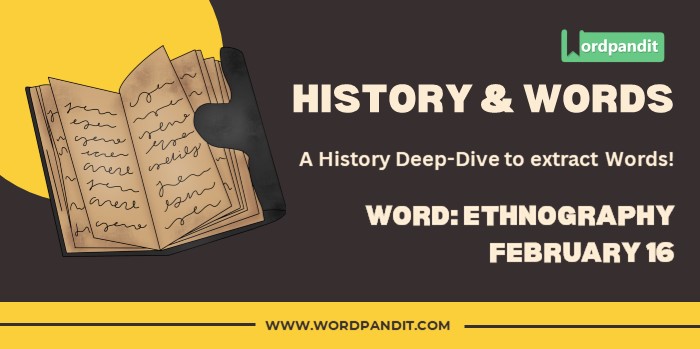History & Words: ‘Ethnography’ (February 16)
Welcome to ‘History & Words.’ 🌟 I’m Prashant, founder of Wordpandit and the Learning Inc. Network. This series combines my passion for language learning with historical context. Each entry explores a word’s significance on a specific date, enhancing vocabulary while deepening understanding of history. Join me in this journey of words through time.
📚 Table of Contents
🔍 Word of the Day: Ethnography
Pronunciation: /ɛθˈnɒɡrəfi/ (eth-NOG-ruh-fee)
🌍 Introduction
On February 16, 1923, archaeologist Howard Carter unsealed the burial chamber of Tutankhamun, marking a pivotal moment not just in archaeology but in the development of ethnographic study. This discovery would revolutionize our understanding of ancient Egyptian culture, religious practices, and social structures through detailed observation and documentation – the cornerstone of ethnographic research.
The word “ethnography” represents far more than just the study of cultures; it embodies a systematic approach to understanding human societies through immersive observation and detailed documentation. While Carter’s discovery provided a snapshot of ancient Egyptian life frozen in time, it highlighted the importance of studying cultural artifacts and practices in their original context.
This methodology has evolved from its colonial origins into a sophisticated research approach that emphasizes the importance of understanding cultures from within, through the eyes of their members, rather than imposing external interpretations.
🌱 Etymology
“Ethnography” combines two Greek words: “ethnos” (ἔθνος) meaning “people” or “nation,” and “graphia” (γραφία) meaning “writing” or “description.” The term emerged in the mid-19th century as European scholars began developing systematic approaches to studying different cultures and societies.
📖 Key Vocabulary
- 🔑 Participant Observation: A research method where the ethnographer actively participates in a community’s daily life while conducting research, balancing involvement with scholarly detachment.
- 🔑 Thick Description: A detailed account that explains not just behavior, but its context and cultural significance, coined by anthropologist Clifford Geertz.
- 🔑 Field Notes: Detailed written observations and reflections recorded by ethnographers during their research, serving as primary source material for analysis.
- 🔑 Cultural Relativism: The principle of understanding and evaluating a culture on its own terms, rather than through the lens of one’s own cultural values.
🏛️ Historical Context
The practice of studying and documenting different cultures dates back to ancient times, with early examples found in the writings of Herodotus and Marco Polo. However, ethnography as a systematic research method emerged during the 19th century, coinciding with European colonial expansion and growing academic interest in understanding diverse human societies.
Early ethnographers often worked within colonial frameworks, their studies sometimes used to support colonial administration. This period, while problematic in its power dynamics, established many of the foundational techniques of ethnographic research, including long-term fieldwork and detailed cultural documentation.
The early 20th century saw a transformation in ethnographic practice, led by anthropologists like Bronisław Malinowski, who emphasized the importance of learning indigenous languages and living among the studied communities. This approach marked a shift from armchair anthropology to participant observation, fundamentally changing how cultural research was conducted.
⏳ Timeline
- 1800s: Early development of ethnography as a systematic field of study
- 1884: Franz Boas begins his groundbreaking work with Indigenous peoples
- 1915-1918: Malinowski’s fieldwork in the Trobriand Islands establishes new standards for ethnographic research
- 1922: Publication of Malinowski’s Argonauts of the Western Pacific
- 1923: Howard Carter’s discovery provides new opportunities for ethnographic study of ancient cultures
- 1967: Publication of The Discovery of Grounded Theory, revolutionizing qualitative research methods
- 1986: James Clifford and George Marcus publish Writing Culture, challenging traditional ethnographic authority
🌟 The Day’s Significance
February 16, 1923, marks a crucial moment in the intersection of archaeology and ethnography. When Howard Carter broke the seals of Tutankhamun’s burial chamber, he didn’t just uncover spectacular treasures; he opened a window into the complex cultural practices of ancient Egypt. This discovery demonstrated how material culture could provide deep insights into social organization, religious beliefs, and daily life of past societies.
The methodological approach used to document and interpret the tomb’s contents exemplified key principles of ethnographic research: detailed observation, contextual analysis, and the importance of understanding artifacts within their cultural framework. The careful cataloging of items, their positions, and their relationships to each other created a rich ethnographic record of ancient Egyptian burial practices.
This event also highlighted the evolution of archaeological practice from mere treasure hunting to a sophisticated study of human culture, incorporating ethnographic methods to better understand the social and cultural significance of archaeological findings.
💬 Quote
“The aim of ethnographic theory is to make sense of possibilities for living freed from the dead weight of foreign domination, material and spiritual.” – Johannes Fabian, anthropologist
🔮 Modern Usage and Reflection
Today, ethnography has expanded beyond its anthropological roots into diverse fields including sociology, marketing, education, and digital studies. Digital ethnography has emerged as researchers adapt traditional methods to study online communities and virtual spaces. The principles of immersive observation and detailed documentation remain central, even as the contexts of study evolve.
🏛️ Legacy
The impact of ethnographic methods extends far beyond academia. Businesses use ethnographic research to understand consumer behavior, healthcare providers employ it to improve patient care, and social organizations utilize it to better serve communities. The emphasis on understanding people in their natural contexts has influenced approaches to problem-solving across multiple disciplines.
🔍 Comparative Analysis
While early ethnographic work often emphasized exotic differences and reinforced colonial perspectives, contemporary ethnography focuses on understanding cultural complexity and challenging power dynamics. Modern practitioners increasingly recognize their own positionality and its influence on their research, leading to more reflexive and ethical approaches.
💡 Did You Know?
🎓 Conclusion
Ethnography’s evolution from a colonial-era tool to a nuanced methodology for understanding human culture reflects broader changes in how we approach cultural study and knowledge creation. The field continues to adapt to new contexts while maintaining its core commitment to deep understanding through immersive observation and careful documentation.
📚 Further Reading
- 📘 Tales of the Field: On Writing Ethnography by John Van Maanen
- 📗 Writing Culture: The Poetics and Politics of Ethnography edited by James Clifford and George Marcus
- 📙 In Search of Respect: Selling Crack in El Barrio by Philippe Bourgois












